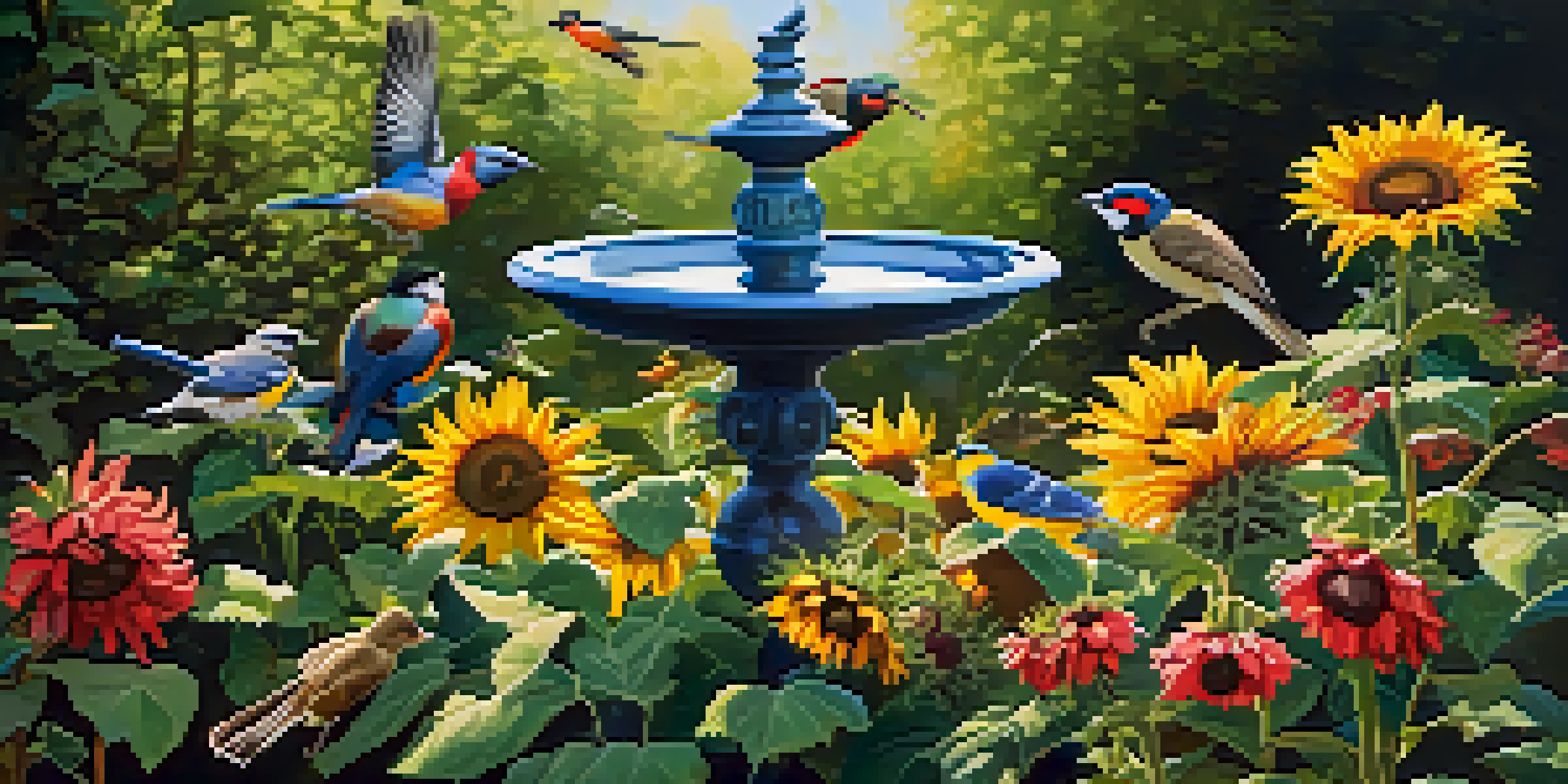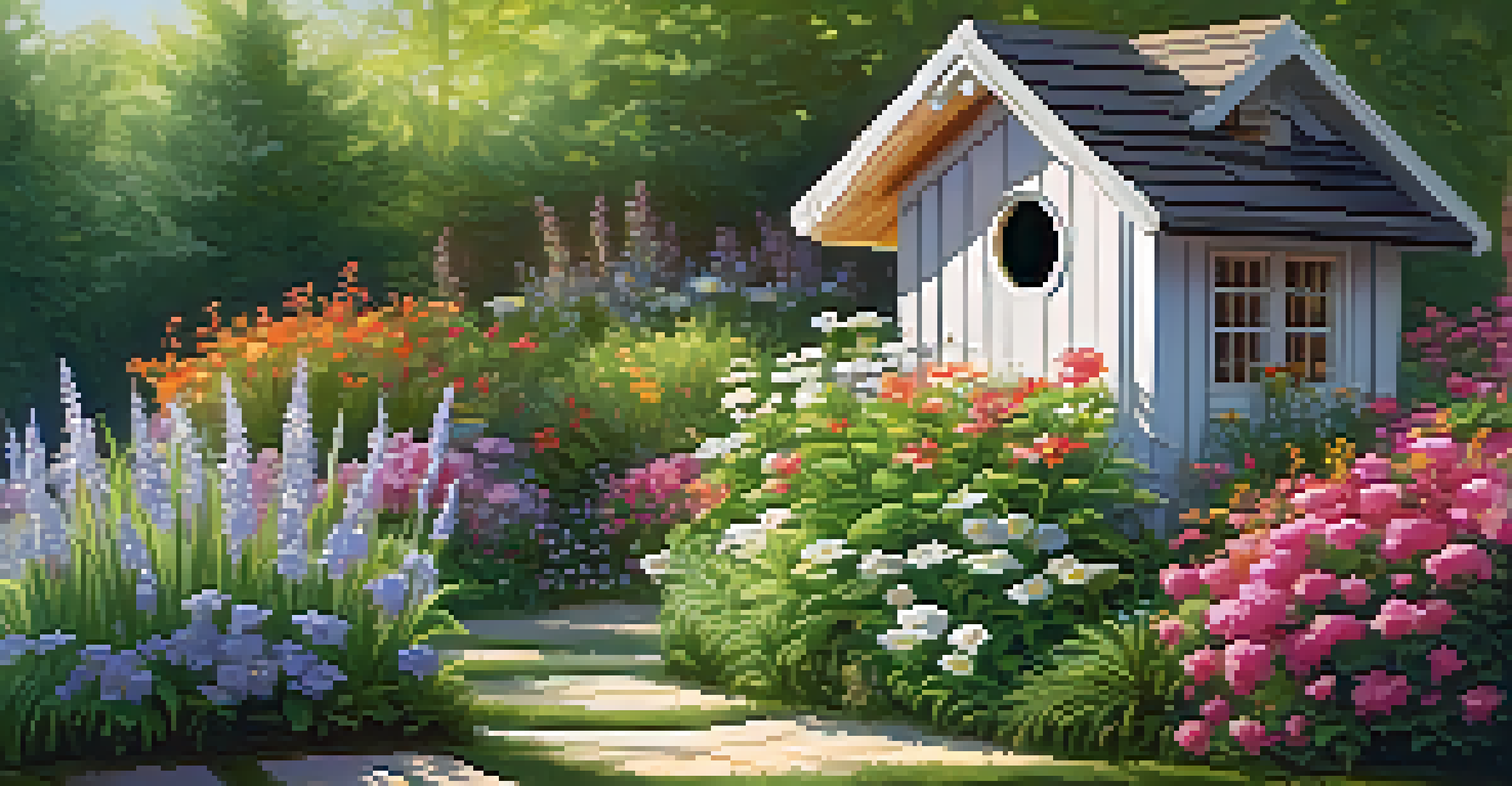Creating a Haven for Birds in Your Home Garden

Understanding the Benefits of Attracting Birds
Birds are not just beautiful to watch; they play a crucial role in our ecosystem. They help control pests by eating insects and assist in pollination, which can lead to healthier plants in your garden. By attracting birds, you’re essentially creating a natural balance in your outdoor space.
Birds are indicators of a healthy environment.
Moreover, having birds around can enhance your gardening experience. Their songs create a soothing atmosphere, making your garden feel like a peaceful retreat. Plus, observing their behavior can be a fascinating hobby, bringing joy and connection to nature.
Lastly, attracting birds can also be educational for families. Children can learn about different species, their habits, and the importance of biodiversity, fostering a sense of responsibility towards the environment.
Choosing the Right Plants for Bird Habitats
Selecting the right plants is essential for creating a bird-friendly garden. Native plants are particularly beneficial as they provide food and shelter that local birds recognize and need. From flowering plants to shrubs and trees, incorporating a variety of species can cater to different bird preferences.

For instance, berry-producing plants such as elderberry or serviceberry will attract fruit-loving birds. Additionally, consider planting sunflowers and coneflowers, which offer seeds that many birds enjoy. A diverse range of plants ensures that your garden is attractive year-round.
Attract Birds for Ecosystem Balance
Birds help control pests, pollinate plants, and enhance the gardening experience, making them vital for a healthy ecosystem.
Moreover, think about the layout of your garden. Birds prefer spaces where they can easily flit between cover and feeding areas. By arranging your plants strategically, you create a safe haven for them to thrive.
Providing Fresh Water Sources for Birds
Water is just as vital for birds as food. Having a fresh water source in your garden can significantly increase the chances of attracting them. A simple birdbath or a small fountain can serve as a delightful oasis for our feathered friends.
The best way to make your bird feeders more inviting is to provide a variety of foods.
Ensure that the water is shallow enough for birds to bathe safely. Regularly changing the water keeps it clean and appealing, which is essential, especially during hot weather or dry spells. Birds will also appreciate a gentle splash, so consider adding a fountain that creates movement.
Remember, it’s not just about drinking; birds enjoy a good bath to maintain their feathers. A clean place to wash up can make your garden a popular stop on their daily journey.
Building Nesting Sites for Birds in Your Garden
Creating nesting sites is a wonderful way to encourage birds to settle in your garden. You can provide natural nesting materials like twigs, leaves, and grasses, or even install birdhouses designed for specific species. Each type of bird has its own preferences, so research what might attract the birds you're interested in.
A well-placed birdhouse can make a cozy home for birds, especially during breeding season. Make sure to consider the height and location of the house, as safety from predators is crucial for nesting birds. Additionally, it’s beneficial to have multiple nesting options to cater to different birds and their varying needs.
Create Bird-Friendly Habitats
Selecting native plants and providing fresh water sources are key to creating inviting spaces for various bird species.
By providing these spaces, you’re not only helping birds but also getting the chance to observe their nesting behaviors. Watching them raise their young can be an incredibly rewarding experience.
Creating Safe Feeding Stations for Birds
Feeding stations are an excellent way to attract birds to your garden. By providing a variety of bird feeders, you can cater to the diverse diets of local bird species. Whether using seed, suet, or nectar feeders, each option offers something unique to entice different birds.
Position your feeders in areas where birds feel safe from predators, yet close enough to cover for quick escapes. Additionally, consider using feeders that are easy to clean and refill, as this will help maintain a healthy environment for your avian visitors.
Moreover, mixing up the types of food you provide can attract a wider variety of birds. From sunflower seeds for finches to hummingbird nectar, a well-stocked feeding station can turn your garden into a bustling bird sanctuary.
Avoiding Harmful Chemicals in Your Garden
One of the best ways to protect birds is by avoiding harmful chemicals in your garden. Pesticides and herbicides can have toxic effects on birds, either directly or through their food supply. By embracing organic gardening practices, you create a safer environment for these creatures.
Consider using natural pest control methods, such as introducing beneficial insects or using companion planting to deter pests. Not only are these methods safer for birds, but they can also improve the health of your garden's ecosystem.
Maintain Your Garden Year-Round
Regular maintenance of feeders, baths, and nesting sites ensures a thriving environment that attracts birds throughout the seasons.
Creating a chemical-free garden not only benefits birds but also contributes to a healthier environment for you and your family. It's a win-win situation that allows you to enjoy gardening while protecting wildlife.
Maintaining Your Bird-Friendly Garden Year-Round
Maintaining a bird-friendly garden is an ongoing process that requires attention throughout the year. Regularly check your feeders, birdbaths, and nesting sites to ensure they are clean and well-stocked. Seasonal changes will also affect which plants and food sources are most beneficial for birds.
In spring and summer, focus on providing plenty of food and water sources as birds are often feeding their young. During the fall and winter months, consider adding more high-energy foods, such as peanuts and suet, to help them through colder weather.

By staying attentive to the needs of your feathered friends, you’ll create a thriving haven that they will appreciate and return to time and time again.